An epitome of luxury and style, the art of Pashmina has always been the centre of attention amongst women all over the world. Being the proud owner of a Pashmina scarf has always meant to experience royalty! And only women who have experienced this royalty can explain the beauty and high worth of a Pashmina scarf. And they have been doing so since times immemorial; explaining to the less aware the uniqueness and timelessness of this fine art. The delicate texture and cozy feel that a Pashmina scarf provides is simply beyond comparison. The know-how, experience, and expertise that the makers of Pashmina put into each piece that they create are noteworthy. And that has been the case since its inception in the 16th century.
Origins of Pashmina
Pashmina represents the art of transforming raw cashmere wool into luxurious shawls, scarves, and other garments. This exquisite fiber comes from the Changthangi goats, native to the high-altitude regions of Ladakh in the Himalayas. These goats grow a fine undercoat of cashmere wool as downfibre. Herders gently comb it off during the molting season to create the renowned Pashmina shawls or scarves.
The history of Pashmina spans centuries and has deep roots in the royal courts of Kashmir. Shah-i-Hamdan, a Persian Sufi saint who traveled to Kashmir in the 14th century, played a pivotal role in introducing the art of Pashmina weaving to the region. His admiration for the softness and warmth of the cashmere wool led him to order a pair of socks made from it. This order marked the beginning of a tradition that would elevate Pashmina to a symbol of luxury and fine craftsmanship.
Over the years, Kashmiri artisans honed their skills in spinning and weaving this delicate fiber. The process of creating Pashmina is both intricate and labor-intensive. Artisans meticulously comb the wool from the goat’s underbelly, spin it into fine threads, and weave it using traditional looms. Artisans perform each step by hand, ensuring that the final product maintains the highest quality. The result is a fabric famous for its incredible softness, lightweight nature, and warmth, making it highly coveted by royalty and the elite around the world.
From its origins in the remote and rugged landscapes of the Himalayas to becoming a cherished luxury item, the journey of Pashmina is a testament to its enduring appeal and the artistry involved in its creation.
History of Pashmina scarves
Even though the art of Pashmina making has existed for millennia, its discovery didn't take place until the late 15th century. The then king of Kashmir - Zain ul Abideen - was the one responsible for creating small manufacturing units. The story behind it is really interesting. Legend says that a Sufi saint by the name of Shah I Hamdan visited the valley from Persia. It was him who discovered raw Cashmere wool and ordered artisans to craft a pair of socks out of it for the king. The king was so impressed with the quality and finesse of Cashmere that he ordered processing units to be set up for manufacturing the same.
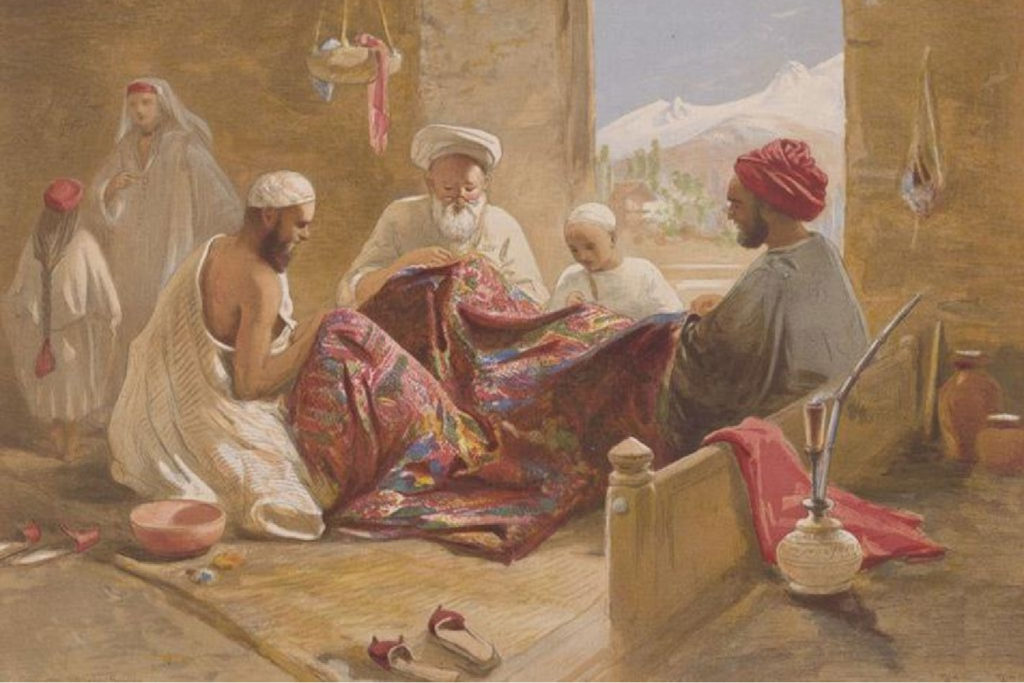
Shah I Hamdan had brought along with him 700 craftsmen from his hometown Persia and many other regions, who had expertise in a number of realms in handicrafts. They in turn trained the locals in the same. Some were carpet weavers, some were Papier Mache artists, some were copper and silver specialists, while some were experts in wood carving. But the ones who knew the art of Pashmina were the most famous, and the maximum number of Kashmiri trainees chose Pashmina art to follow. Artisans could now make Pashmina shawls, Pashmina scarves, and stoles in an unparalleled manner, yet it would take days together to do so.
Pashmina in the Mughal Period
Later Pashmina art saw a blooming period in Mughal Emperor Akber's rule. Akber showed a keen interest in Pashmina. So, it was in his time when artisans introduced a number of new patterns and embroidery motifs into the art. Pashmina scarves became more beautiful and colourful when artisans embroidered them. Later Emperor Akbar as well as Emperor Jehangir mentioned Pashmina in their biographies, overwhelmed by the craft.
In the 18th century, Pashmina art reached Europe and became an accessory that every European cherished. French conqueror and monarch Napoleon is believed to have purchased Pashmina shawls on his way from a conquest, for his wife Empress Josephine. The empress loved the piece so much that she later owned a few hundred of the same. It was a Kani shawl.
Where is Cashmere found?
Many of us probably won't know, but Pashmina is the art of handcrafting luxury scarves from Cashmere wool. Cashmere wool grows as a downfibre on the exotic Ladakhi Pashmina goat which inhabits a region called Changthang. The area lies over 14,000 feet above sea level and witnesses a temperature of as low as -40°C (-40°F) in winter. It is the winter season when the goat grows an extremely soft and warm fleece over the most sensitive parts of its body like the underbelly and throat in order to survive. This is the reason they endure such harsh climatic conditions.
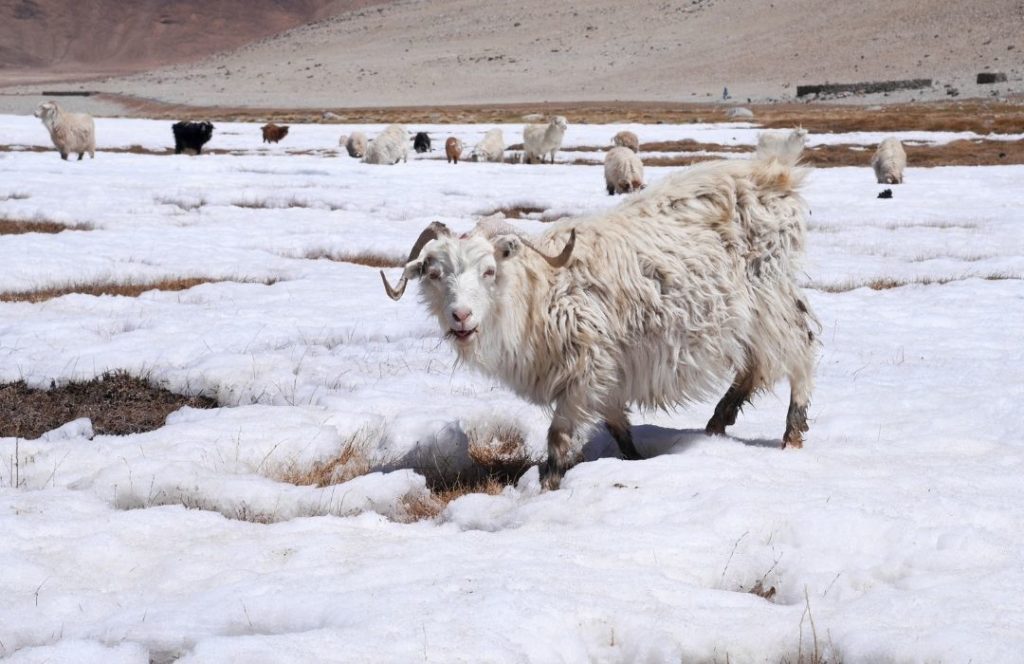
As soon as spring and early summer arrive, the goats become too uncomfortable and get rid of some portion of this wool by rubbing themselves against harsh surfaces like bushes, rough walls, and rocks. Local herders gather and keep safe the scattered wool. But even then, some portion of Cashmere wool is still left on the body of the goat. Professionals and herders together ethically remove this portion by using specialized combs, as soon as hot summer arrives. Hence, the wool is a kind of defense mechanism for the goat to survive in winters and a luxurious and comfortable accessory for us.
Also read: The trail of India's cashmere goat men
Processing of the wool
To make one shawl (100*200 cms), the raw wool from three or four goats is enough. One goat yields about 80 to 170 grams (3 to 6 ounces) of fiber. And while processing, much of even this small quantity is lost while cleaning, spinning, and weaving processes.
Herders pass the wool acquired as such to womenfolk of Kashmir. Women start by cleaning the raw wool which is full of dirt, dust, foreign materials, and thick guard hair, and needs to be freed from all foreign material. Women sit together in groups and start sorting and cleaning the hair. After cleaning, women send it to another group of women, who spin the wool into long yarns which are further processable.
Spinning the raw wool
Women artisans spin the wool on a wooden spinning wheel to convert it into long yarns. The wheel can produce yarn as fine as ones having 12-15 microns diameter. Weavers collect these delicate yarn threads and mount the long yarn onto wooden handlooms, traditional to the valley. It should be noted that this handloom is not the handloom that is generally used, but native to Kashmir. It has a wooden strructure and artisans perform most of the activities manually over it. A scarf has the standard size of 70* 200 cm (approx)
Weaving a Pashmina scarf
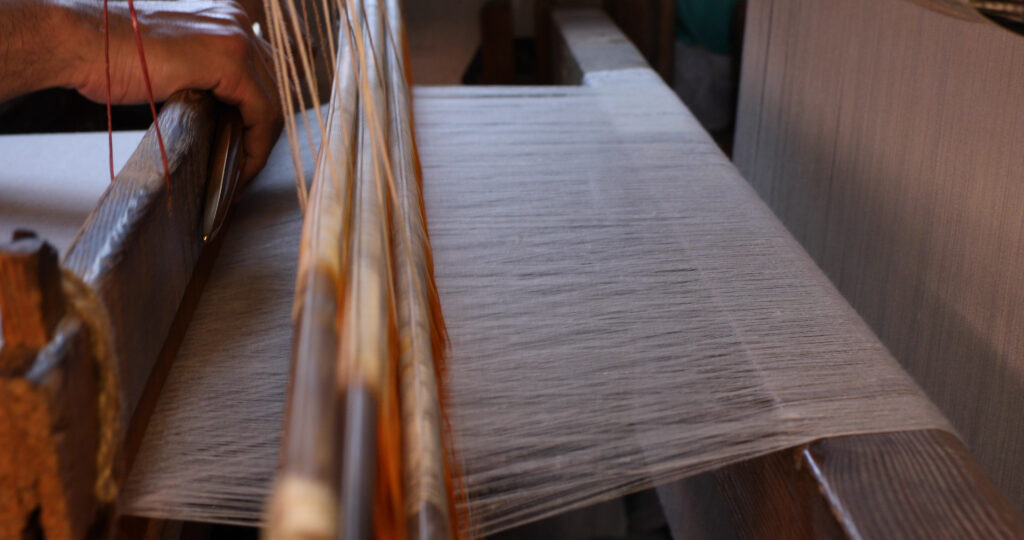
Two men sit at a time over a handloom and assist each other in weaving the entire piece. The workers are highly skilled weavers. They have experience of more than 30 or 40 years. At the end of three or four days, a plain Pashmina scarf is ready. Weavers send it for finishing touches like removal of extra fibres on the surface, trimming of edges, and embroidery.
A Pashmina scarf can be an embroidered one. Artisans embroider it in three different patterns - Tilla Dozi, Papier Mache embroidery, and Sozni embroidery. It is up to the customer what he or she requires. Embroidery artisans do all the embroideries manually, using fine threads and needles. Colourful and intricate motifs leave the shawl looking classic and vintage.
What is a Pashmina Scarf?
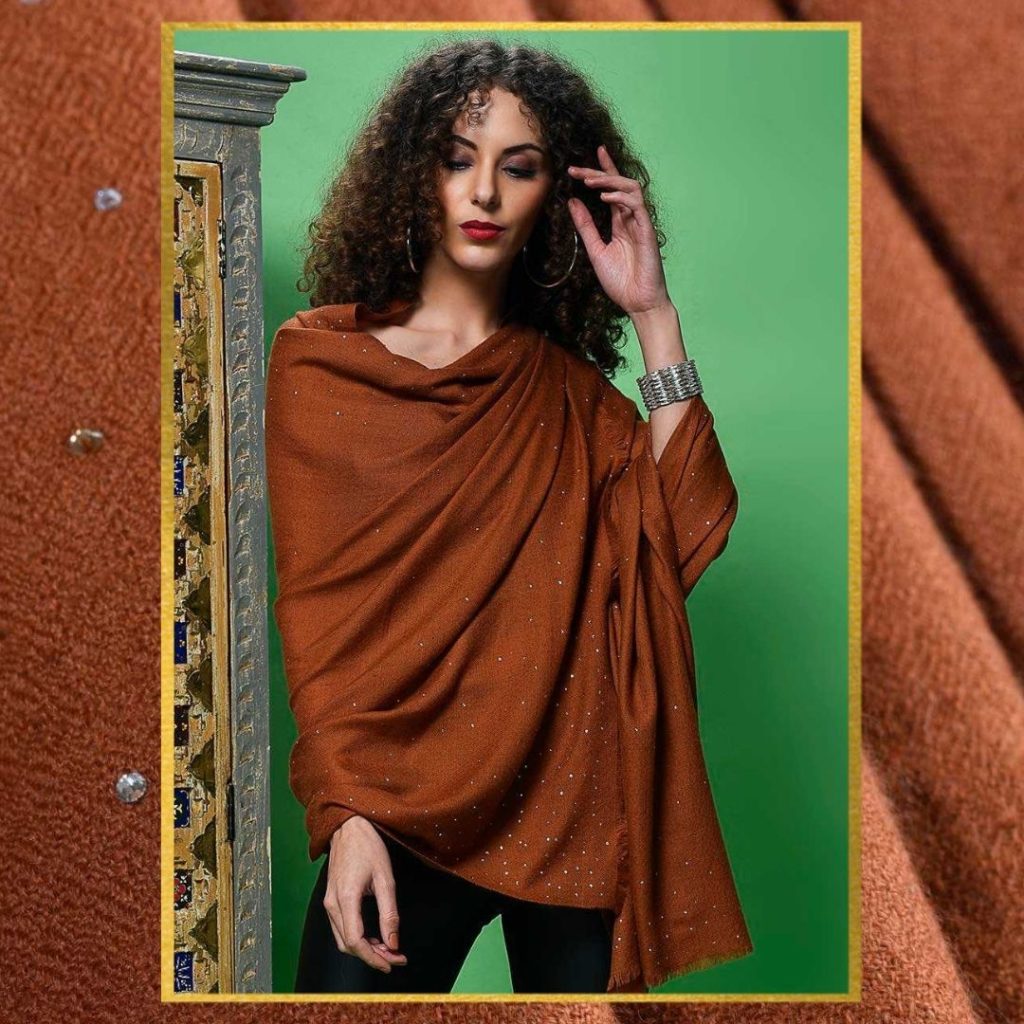
Although it is Pashmina shawls that are more renowned, Pashmina scarves too are in huge demand. But what is a Pashmina scarf? It all began with the luxury fabric being used in royal courts as decorative items. Then Pashmina was used as a gift to present to rulers as 'khilat' to improve political relations. Gradually, as Pashmina spread in the west, it took different sizes and patterns. Westerners did start with embroidered shawls and Kani shawls, but they switched to a certain scarf size because their culture didn't support shawls. Hence, a size of 70*200 cm was carved out of the cashmere fabric and introduced as a scarf.
Pashmina scarf in Modern Times
In the current times, Pashmina scarves are new modern accessories, which have been modernized to suit the new preferences. Instead of hand embroidery, new patterns like check and stripes, prints like animal and floral prints, and embellishments like laces and crystals have been bestowed upon these luxury pieces. Women now wear Pashmina scarves with western wear like jeans, skirts, and dresses. In fact, formal wear is even paired with nude shaded solid Pashmina scarves which give a sophisticated touch to the overall look.
The Purity of Pashmina Scarf | Sustainability
Even if Pashmina has managed to blend with modern preferences, it has lost the glory that it enjoyed once. While Pashmina scarves were only handmade, certain traders' greed compelled them to introduce mechanized Pashmina scarves, and hence ruin the trade altogether. To bear the strain of the machine, Cashmere yarn is mixed with nylon or any strengthening fibre. The scarf made in this manner doesn't remain pure. Pashmina art is a sustainable one and patronizes slow fashion since its conception. There is the least wastage, and the scarf remains with the owner for a long time only when it is pure. Pure Pashmina is believed to stay fresh for more than 20 years. The industry has survived small enterprises locally and still continues to do so.
Patterns in Pashmina scarves
Solid Pashmina scarves
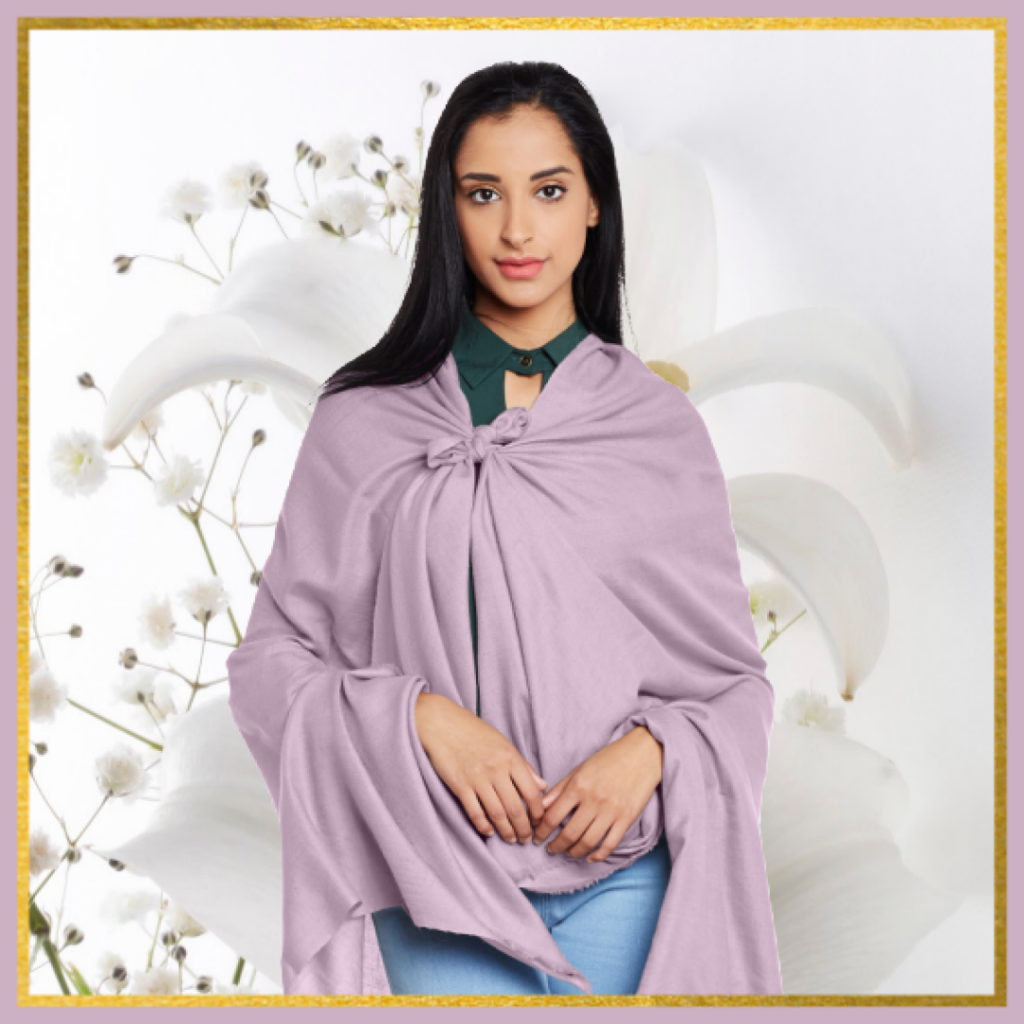
Solid scarves are kept plain, without any embellishments. Soon after hand-weaving them, solid Pashmina scarves are dyed, washed, dried, and ironed. Such scarves are ideal for formal and semi-formal outfits.
Printed and Patterned Pashmina scarves
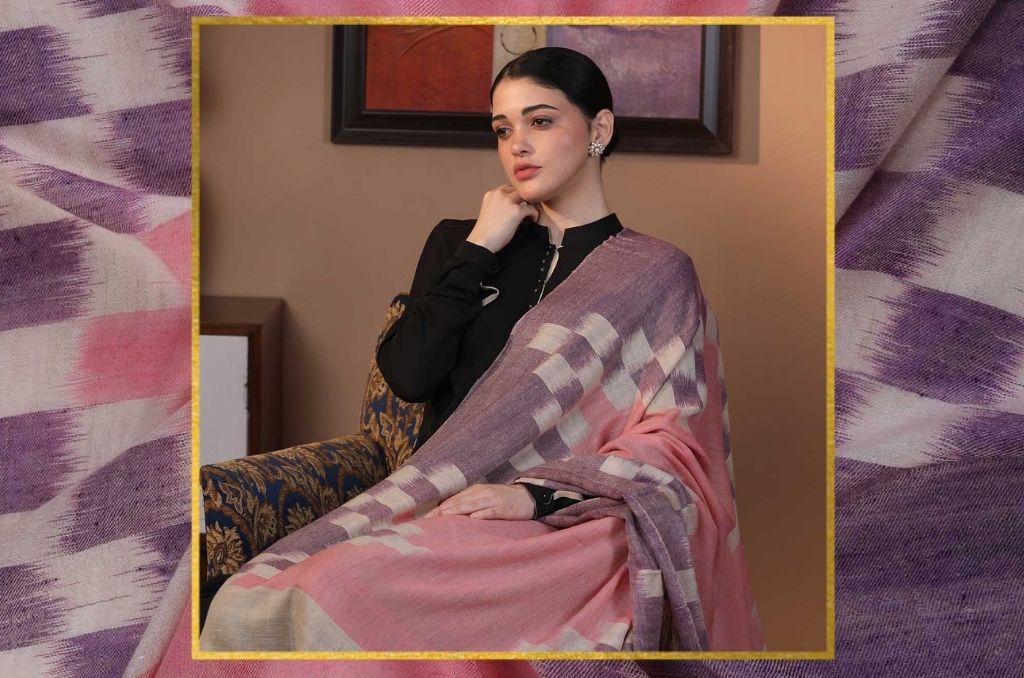
Printed scarves feature modern prints like floral prints, animal prints, or abstract prints. Patterned Pashmina scarves are patterned with checks, tartans, stripes, or ancient Mughal architecture-inspired patterns. These types of scarves are ideal for casual get-togethers with friends or weekend brunches with family
Reversible Pashmina scarves
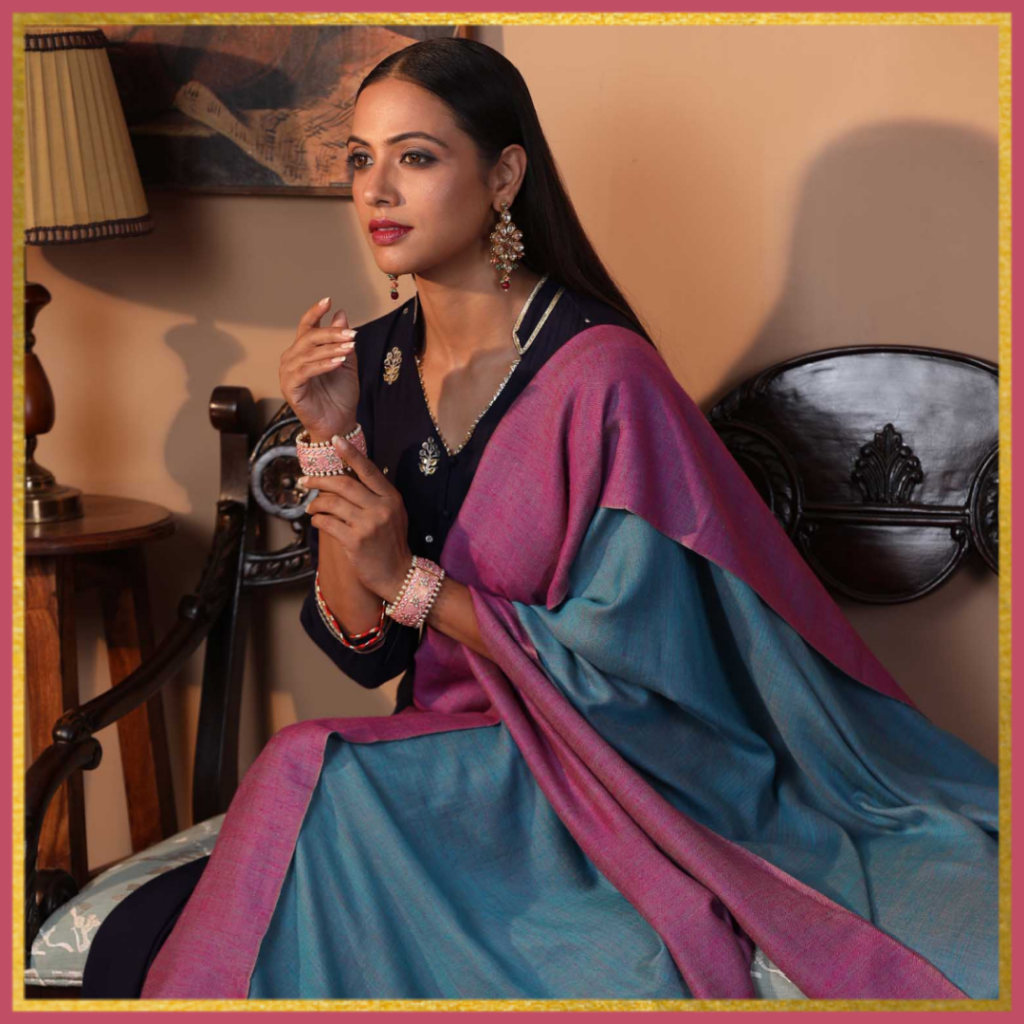
Reversible Pashmina scarves are a marvel, in the sense that they feature a unique type of weave. The scarves are woven such that the front and the backside are a mirror image of each other, and the scarf looks ravishing from both sides.
Swarovski and Lace Pashmina scarves
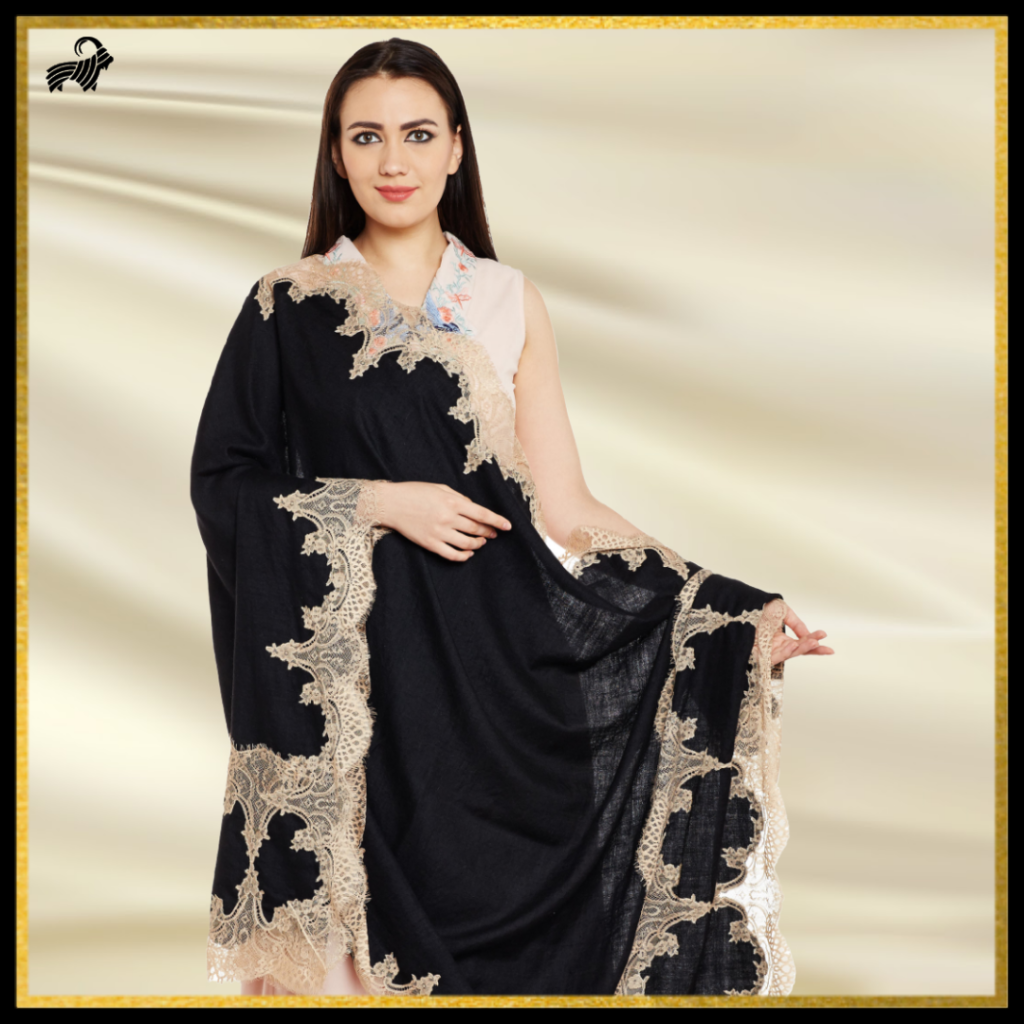
Semi-formal events demand something formal as well as chic. For such occasions, Pashmina scarves have been embellished with Swarovski crystals or French laces for a dainty look for semi-formal events. These types of scarves can be gifted to a bride-to-be, and she can drape them on after wedding events.
Kani Pashmina scarves
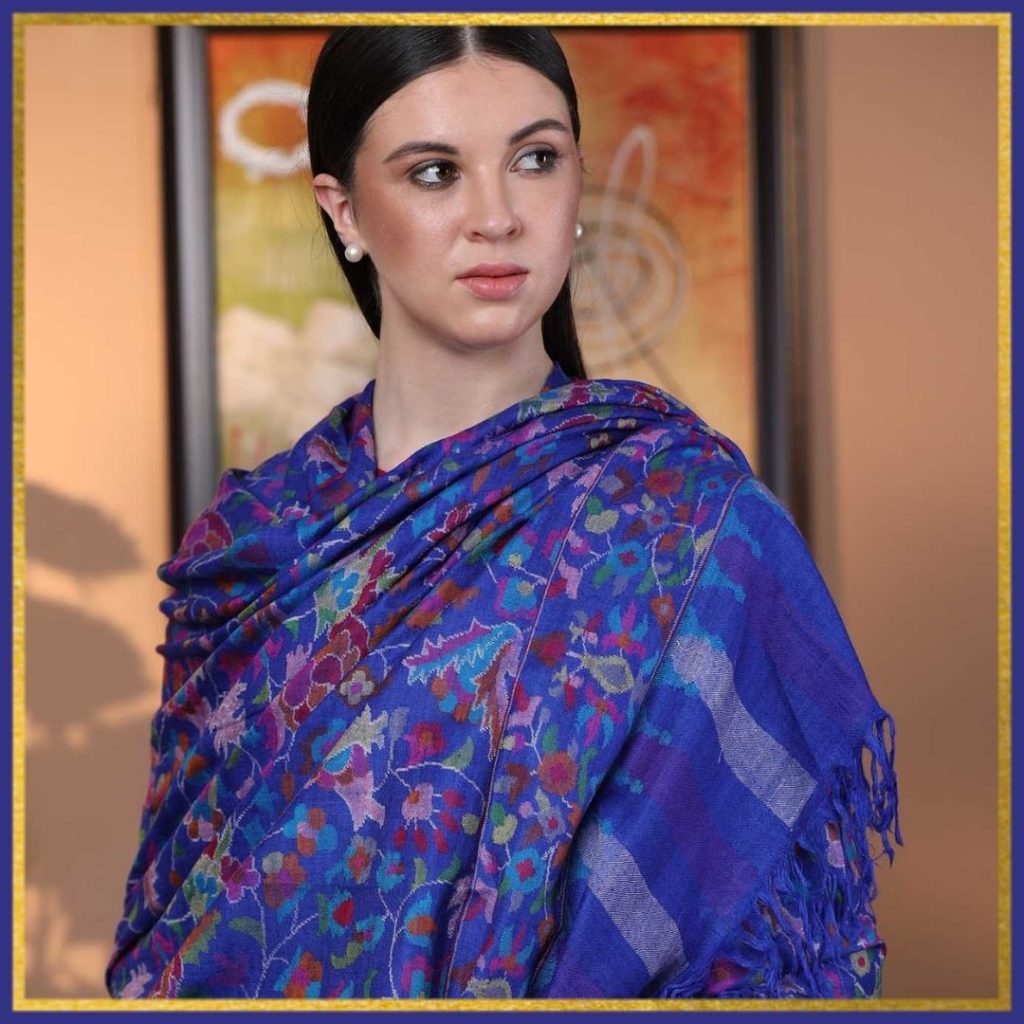
Heavy Kani scarves are a bit on the expensive side of the price scale. Kani work is really meticulous and takes even years to complete. Hence, these are draped on weddings and special events where ardent patrons of handicrafts are expected to gather
Hand Embroidered Pashmina scarves
Handmade and hand-embroidered scarves are luxury gifting pieces. People have used them as royal gifts for centuries in Kashmir. And even now in Kashmir, a mother gifts her daughter a pure Pashmina, as an important part of her wedding trousseau. There are a number of embroideries that artisans do on Pashmina scarves. A few of them are:
Sozni Embroidery
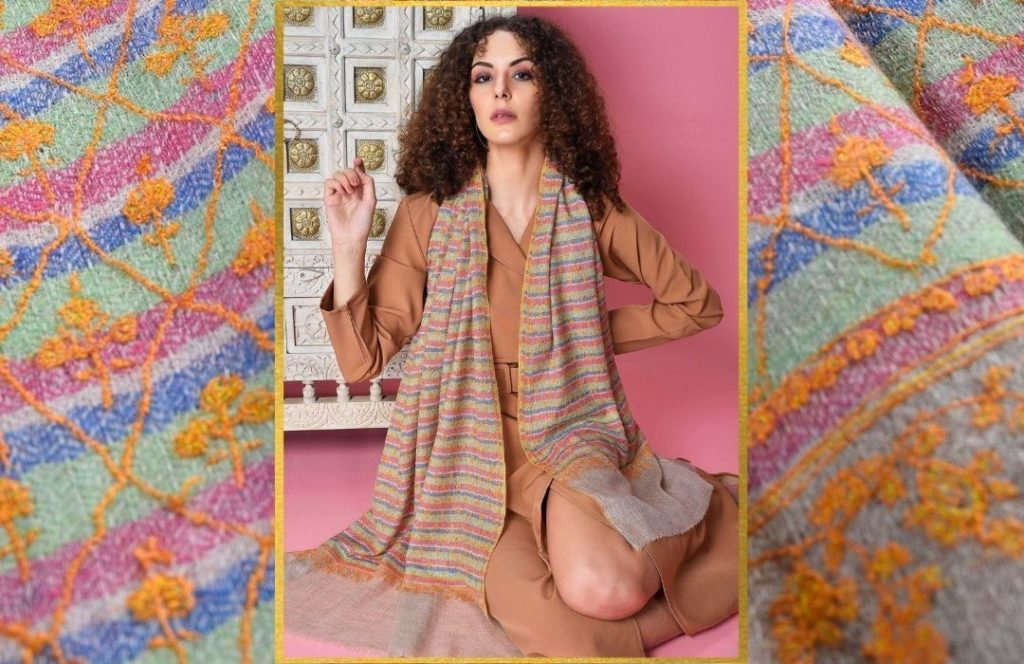
Sozni embroidery is thread embroidery that artisans do by hand. It includes fine threads and needles with which highly experienced embroidery artisans create intricate motifs for days together. A fully hand embroidered scarf often takes years together to complete. Sozni scarves are ideal for everyday use, or fully embroidered ones might help with special occasions.
Papier Mache Embroidery
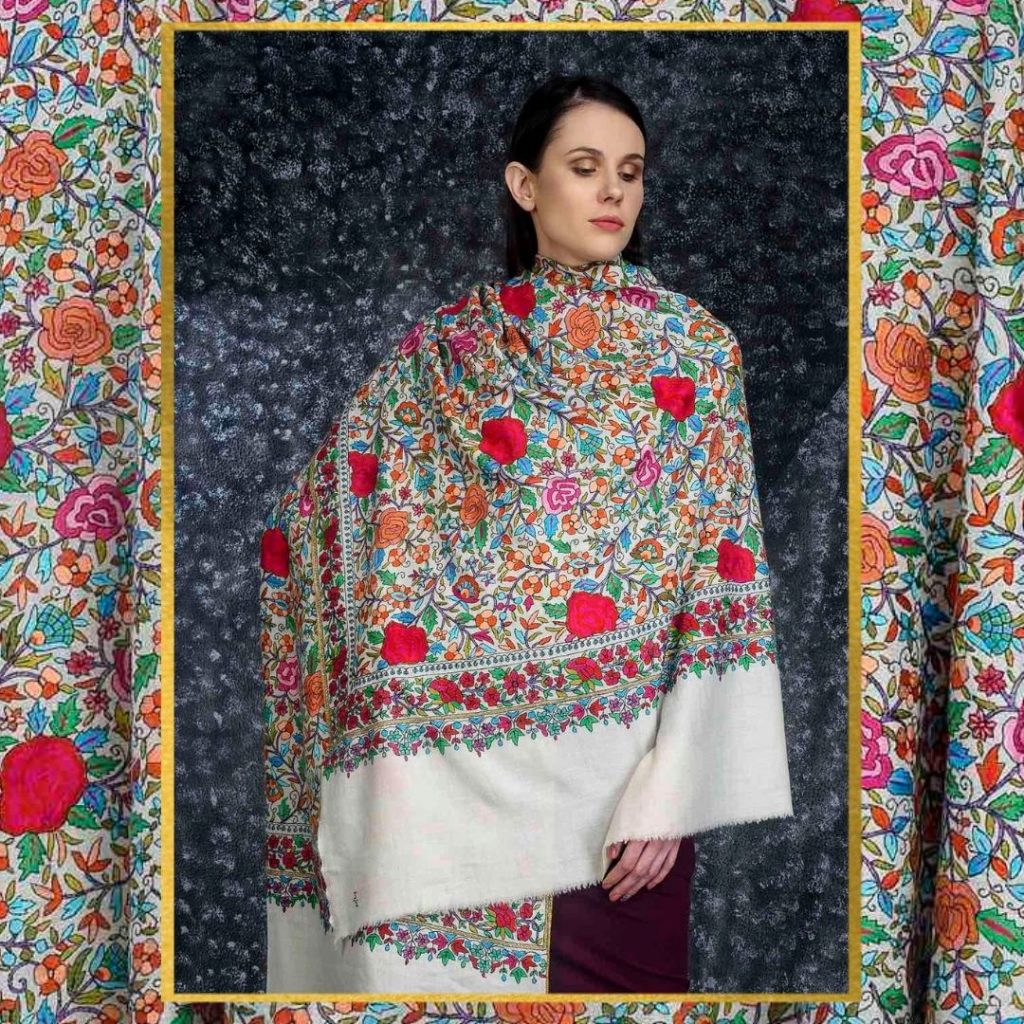
Papier Mache embroidery uses brighter and thicker threads than those used in Sozni embroidery. Usually, artisans use silk threads with bright colours. As such, this embroidery gives a deeper effect and the motifs thus created look more protruding and attractive. Papier Mache embroidery is usually thick and deep shaded, hence women often wrap Papier Mache scarves on festive occasions or weddings. Those with Jamawar embroidery patterns spread all over the base are kept safe for brides. Brides wear Jamawar shawls as they bid goodbye to their home place.
Tilla Embroidery
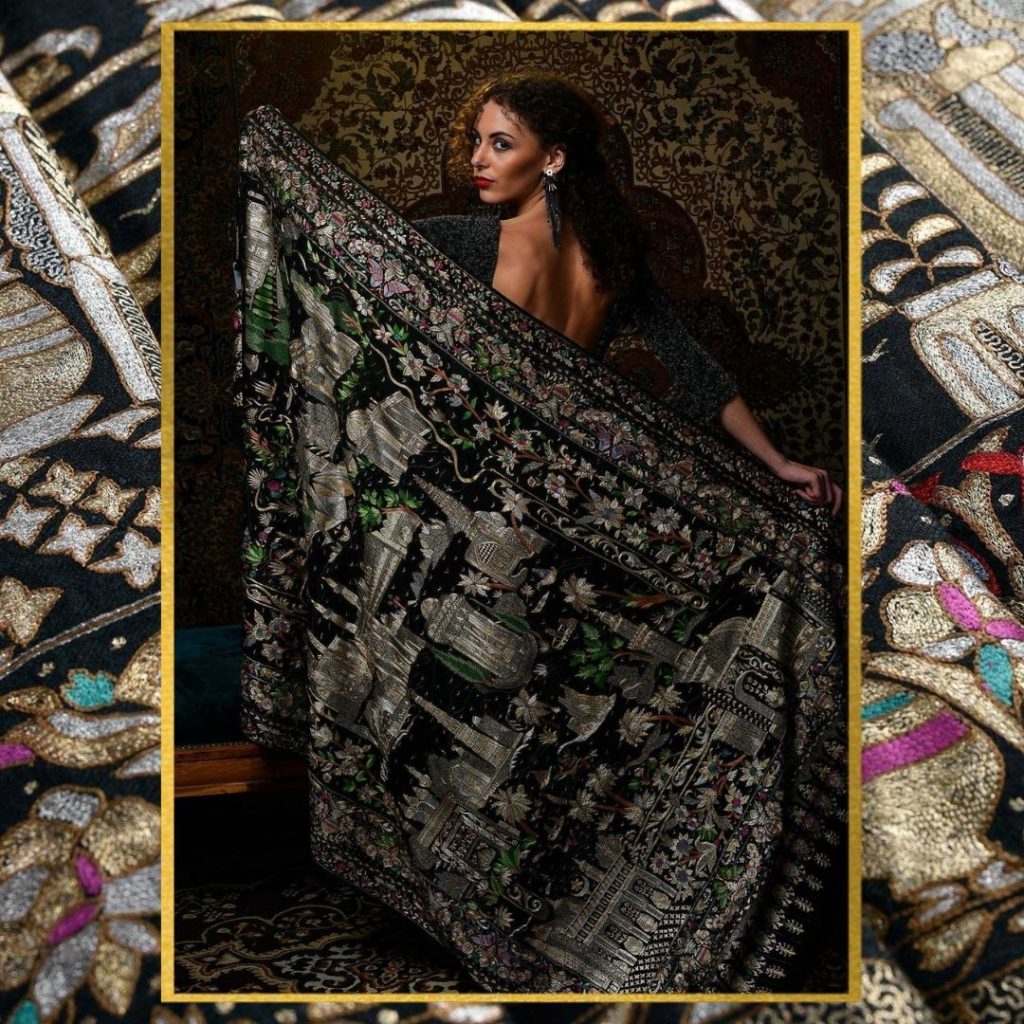
Tilla embroidery, in ancient times, was so expensive that only royalty could afford it. This was because it used real gold and silver threads to create motifs over the base. But nowadays Tilla uses threads of metal dipped in gold or silver. This embroidery makes the stole look straight out of a royal wardrobe. Tilla embroidered shawls and scarves are mostly for weddings and bridal purposes. Some also give these as gifts to those valued the most.
Why Pashmina Scarves have High Valued
Pashmina scarves are famous for their unparalleled luxury and exquisite craftsmanship, making them highly sought-after accessories. But what is a Pashmina scarf that makes it so valuable?
Firstly, the intrinsic quality of the material plays a crucial role. Pashmina comes from the soft undercoat of Changthangi goats, found in the high-altitude regions of Ladakh. This cashmere wool is incredibly fine and soft, offering a warmth that surpasses regular wool while remaining lightweight. The unique properties of Pashmina wool contribute significantly to the scarf’s exceptional comfort and elegance.
The craftsmanship involved in creating Pashmina scarves adds to their value. The process is meticulous and labor-intensive, with artisans hand-combing the wool, spinning it into fine threads, and weaving it on traditional looms. Each scarf undergoes an intricate process of hand-weaving and sometimes embellishment with detailed embroidery. This craftsmanship ensures that every Pashmina scarf is not only a piece of clothing but also a work of art.
Additionally, Pashmina scarves have a rich cultural heritage, which enhances their desirability. Originating from the royal courts of Kashmir, Pashmina associates with luxury and sophistication for centuries. The historical significance and the tradition of its production elevate its status as a high-value item.
Finally, the versatility and timeless appeal of Pashmina scarves make them a desirable addition to any wardrobe. One can style them in numerous ways, making them suitable for both casual and formal occasions. This adaptability, combined with their inherent beauty and comfort, ensures that Pashmina scarves remain a cherished and valuable accessory.
In summary, the value of a Pashmina scarf lies in its exceptional material quality, intricate craftsmanship, rich cultural heritage, and versatile styling options. Understanding "What is a Pashmina scarf" highlights why people around the world highly value them.
Caring for Your Pashmina Scarf: Tips for Longevity
To maintain the beauty and longevity of your Pashmina scarf, follow these essential care tips.
1. Hand Wash Gently
Always hand wash your Pashmina scarf in cold water using a mild detergent designed for delicate fabrics. Avoid hot water as it can shrink the fibers. Gently agitate the water and let the scarf soak for about 10-15 minutes. Avoid wringing or twisting the fabric, which can damage its texture.
2. Rinse Thoroughly
Rinse the scarf in cold water until all soap residues are gone. Gently press the water out without wringing.
3. Dry Carefully
Lay the scarf flat on a clean, dry towel to air dry. Reshape it gently to its original form. Avoid hanging the scarf or exposing it to direct sunlight, as this can cause stretching and fading. Do not use a tumble dryer, as the heat can damage the delicate fibers.
4. Store Properly
Store your Pashmina scarf in a cool, dry place. Keep it in a breathable garment bag or a cotton pillowcase to protect it from dust and moisture. Avoid storing it in direct sunlight or in a damp environment.
5. Avoid Frequent Washing
Pashmina scarves do not need frequent washing. Instead, air them out after wearing to refresh the fabric. For minor stains, spot clean with a damp cloth and mild detergent.
By following these care tips, you ensure that your Pashmina scarf remains in excellent condition, retaining its luxurious feel and timeless elegance for years to come.
Conclusion
To have a pure Pashmina scarf is always better than having the one whose purity you doubt. Always choose a trustworthy seller when you buy a Pashmina. When you buy an authentic piece, it is thousands of local underprivileged Kashmiri artisans whose efforts you are supporting and whose art you are encouraging. Besides an authentic Pashmina will carry an unmatched grace and keep you ever stylish and comfortable for years to come.